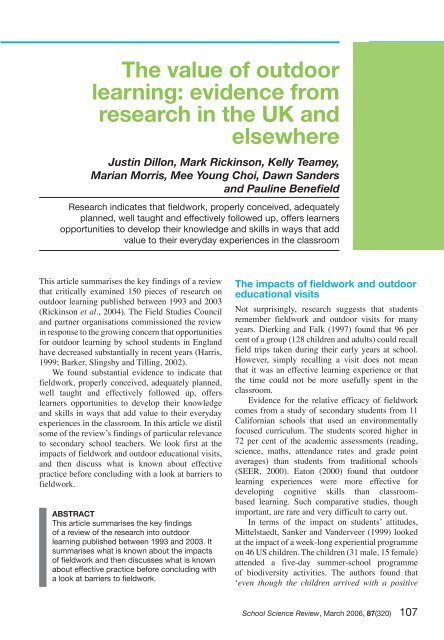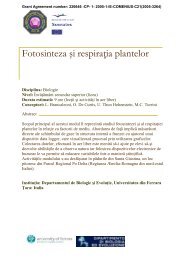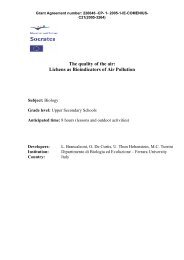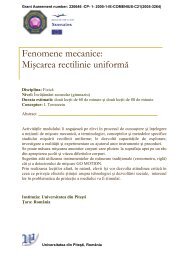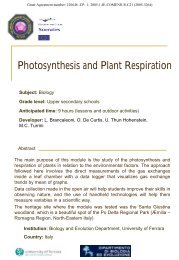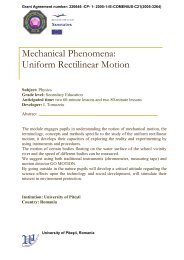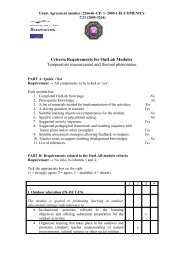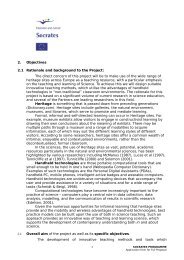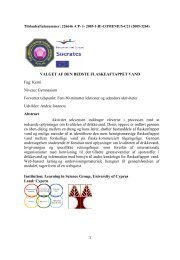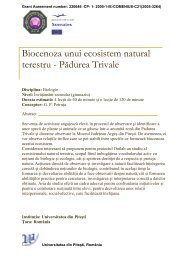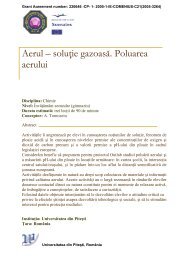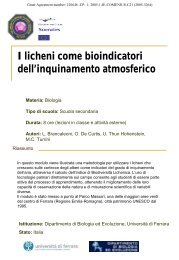The value of outdoor learning: evidence from research in the UK ...
The value of outdoor learning: evidence from research in the UK ...
The value of outdoor learning: evidence from research in the UK ...
You also want an ePaper? Increase the reach of your titles
YUMPU automatically turns print PDFs into web optimized ePapers that Google loves.
Dillon et al. <strong>The</strong> <strong>value</strong> <strong>of</strong> <strong>outdoor</strong> <strong>learn<strong>in</strong>g</strong><br />
<strong>The</strong> <strong>value</strong> <strong>of</strong> <strong>outdoor</strong><br />
<strong>learn<strong>in</strong>g</strong>: <strong>evidence</strong> <strong>from</strong><br />
<strong>research</strong> <strong>in</strong> <strong>the</strong> <strong>UK</strong> and<br />
elsewhere<br />
Just<strong>in</strong> Dillon, Mark Rick<strong>in</strong>son, Kelly Teamey,<br />
Marian Morris, Mee Young Choi, Dawn Sanders<br />
and Paul<strong>in</strong>e Benefield<br />
Research <strong>in</strong>dicates that fieldwork, properly conceived, adequately<br />
planned, well taught and effectively followed up, <strong>of</strong>fers learners<br />
opportunities to develop <strong>the</strong>ir knowledge and skills <strong>in</strong> ways that add<br />
<strong>value</strong> to <strong>the</strong>ir everyday experiences <strong>in</strong> <strong>the</strong> classroom<br />
This article summarises <strong>the</strong> key f<strong>in</strong>d<strong>in</strong>gs <strong>of</strong> a review<br />
that critically exam<strong>in</strong>ed 150 pieces <strong>of</strong> <strong>research</strong> on<br />
<strong>outdoor</strong> <strong>learn<strong>in</strong>g</strong> published between 1993 and 2003<br />
(Rick<strong>in</strong>son et al., 2004). <strong>The</strong> Field Studies Council<br />
and partner organisations commissioned <strong>the</strong> review<br />
<strong>in</strong> response to <strong>the</strong> grow<strong>in</strong>g concern that opportunities<br />
for <strong>outdoor</strong> <strong>learn<strong>in</strong>g</strong> by school students <strong>in</strong> England<br />
have decreased substantially <strong>in</strong> recent years (Harris,<br />
1999; Barker, Sl<strong>in</strong>gsby and Till<strong>in</strong>g, 2002).<br />
We found substantial <strong>evidence</strong> to <strong>in</strong>dicate that<br />
fieldwork, properly conceived, adequately planned,<br />
well taught and effectively followed up, <strong>of</strong>fers<br />
learners opportunities to develop <strong>the</strong>ir knowledge<br />
and skills <strong>in</strong> ways that add <strong>value</strong> to <strong>the</strong>ir everyday<br />
experiences <strong>in</strong> <strong>the</strong> classroom. In this article we distil<br />
some <strong>of</strong> <strong>the</strong> review’s f<strong>in</strong>d<strong>in</strong>gs <strong>of</strong> particular relevance<br />
to secondary school teachers. We look first at <strong>the</strong><br />
impacts <strong>of</strong> fieldwork and <strong>outdoor</strong> educational visits,<br />
and <strong>the</strong>n discuss what is known about effective<br />
practice before conclud<strong>in</strong>g with a look at barriers to<br />
fieldwork.<br />
ABSTRACT<br />
This article summarises <strong>the</strong> key f<strong>in</strong>d<strong>in</strong>gs<br />
<strong>of</strong> a review <strong>of</strong> <strong>the</strong> <strong>research</strong> <strong>in</strong>to <strong>outdoor</strong><br />
<strong>learn<strong>in</strong>g</strong> published between 1993 and 2003. It<br />
summarises what is known about <strong>the</strong> impacts<br />
<strong>of</strong> fieldwork and <strong>the</strong>n discusses what is known<br />
about effective practice before conclud<strong>in</strong>g with<br />
a look at barriers to fieldwork.<br />
<strong>The</strong> impacts <strong>of</strong> fieldwork and <strong>outdoor</strong><br />
educational visits<br />
Not surpris<strong>in</strong>gly, <strong>research</strong> suggests that students<br />
remember fieldwork and <strong>outdoor</strong> visits for many<br />
years. Dierk<strong>in</strong>g and Falk (1997) found that 96 per<br />
cent <strong>of</strong> a group (128 children and adults) could recall<br />
field trips taken dur<strong>in</strong>g <strong>the</strong>ir early years at school.<br />
However, simply recall<strong>in</strong>g a visit does not mean<br />
that it was an effective <strong>learn<strong>in</strong>g</strong> experience or that<br />
<strong>the</strong> time could not be more usefully spent <strong>in</strong> <strong>the</strong><br />
classroom.<br />
Evidence for <strong>the</strong> relative efficacy <strong>of</strong> fieldwork<br />
comes <strong>from</strong> a study <strong>of</strong> secondary students <strong>from</strong> 11<br />
Californian schools that used an environmentally<br />
focused curriculum. <strong>The</strong> students scored higher <strong>in</strong><br />
72 per cent <strong>of</strong> <strong>the</strong> academic assessments (read<strong>in</strong>g,<br />
science, maths, attendance rates and grade po<strong>in</strong>t<br />
averages) than students <strong>from</strong> traditional schools<br />
(SEER, 2000). Eaton (2000) found that <strong>outdoor</strong><br />
<strong>learn<strong>in</strong>g</strong> experiences were more effective for<br />
develop<strong>in</strong>g cognitive skills than classroombased<br />
<strong>learn<strong>in</strong>g</strong>. Such comparative studies, though<br />
important, are rare and very difficult to carry out.<br />
In terms <strong>of</strong> <strong>the</strong> impact on students’ attitudes,<br />
Mittelstaedt, Sanker and Vanderveer (1999) looked<br />
at <strong>the</strong> impact <strong>of</strong> a week-long experiential programme<br />
on 46 US children. <strong>The</strong> children (31 male, 15 female)<br />
attended a five-day summer-school programme<br />
<strong>of</strong> biodiversity activities. <strong>The</strong> authors found that<br />
‘ even though <strong>the</strong> children arrived with a positive<br />
School Science Review , March 2006, 87 (320) 107
<strong>The</strong> <strong>value</strong> <strong>of</strong> <strong>outdoor</strong> <strong>learn<strong>in</strong>g</strong> Dillon et al.<br />
attitude toward <strong>the</strong> environment, <strong>the</strong>y left with an<br />
even stronger positive attitude’(p. 147). Uzzell and<br />
colleagues, however, sound a note <strong>of</strong> caution about<br />
mak<strong>in</strong>g too many assumptions about <strong>the</strong> relative<br />
permanency <strong>of</strong> attitud<strong>in</strong>al changes (Uzzell, Rutland<br />
and Whistance, 1995). <strong>The</strong> <strong>research</strong>ers po<strong>in</strong>t out that<br />
environmental attitudes are fairly well entrenched:<br />
‘ What <strong>the</strong>y learn ... both <strong>in</strong> <strong>the</strong> classroom and <strong>in</strong><br />
<strong>the</strong> field, only serves to streng<strong>the</strong>n <strong>the</strong>ir views and<br />
perhaps heighten <strong>the</strong>ir sense <strong>of</strong> action paralysis ’(p.<br />
177).<br />
In terms <strong>of</strong> chang<strong>in</strong>g students’ behaviours,<br />
Bogner (1998) tested one-day and five-day versions<br />
<strong>of</strong> a long-established <strong>outdoor</strong> ecological programme<br />
with 700 students aged 11–13 <strong>in</strong> a German national<br />
park. Bogner reported that ‘ <strong>the</strong> 5-day program<br />
explicitly provoked favorable shifts <strong>in</strong> <strong>in</strong>dividual<br />
behavior, both actual and <strong>in</strong>tended’ (p. 17).<br />
What counts as effective practice?<br />
<strong>The</strong>re is considerable <strong>evidence</strong> <strong>in</strong>dicat<strong>in</strong>g that longer<br />
programmes are more effective than shorter ones. A<br />
studybyEmmons (1997) <strong>of</strong>an<strong>outdoor</strong> environmental<br />
education programme <strong>in</strong> Belize argued that:<br />
<strong>the</strong> length <strong>of</strong> time that students spent at<br />
Cockscomb (five days for most) appeared<br />
to be important <strong>in</strong> <strong>the</strong> reduction <strong>of</strong> negative<br />
perceptions <strong>of</strong> <strong>the</strong> environment, <strong>in</strong>clud<strong>in</strong>g<br />
fears ... A shorter environmental education<br />
programme may not have had <strong>the</strong> same effect.<br />
(p. 342)<br />
Bogner’s (1998) evaluation, mentioned above, found<br />
that ‘only <strong>the</strong> residential five-day programme had<br />
any effect on behavioural levels ’ (p. 26).<br />
<strong>The</strong> <strong>value</strong> <strong>of</strong> preparatory work prior to <strong>outdoor</strong><br />
<strong>learn<strong>in</strong>g</strong> is ano<strong>the</strong>r factor well-<strong>evidence</strong>d <strong>in</strong> <strong>the</strong><br />
literature. For example, <strong>in</strong> <strong>the</strong>ir study <strong>of</strong> naturebased<br />
excursions <strong>in</strong> Queensland, Ballantyne<br />
and Packer (2002) found significant differences<br />
between students who had done pre-visit activities<br />
and those who had not. <strong>The</strong> former both looked<br />
forward to, and enjoyed, <strong>the</strong>ir visit more than <strong>the</strong><br />
latter. Work by Orion and H<strong>of</strong>ste<strong>in</strong> (1994) <strong>in</strong> Israel<br />
provides a strong rationale for preparatory work<br />
that <strong>in</strong>troduces students to <strong>the</strong> cognitive (field trip<br />
concepts and skills), geographic (field trip sett<strong>in</strong>g),<br />
and psychological (field trip processes) aspects <strong>of</strong><br />
fieldwork. <strong>The</strong> benefit <strong>of</strong> preparatory meet<strong>in</strong>gs,<br />
discussions, explanations and materials for creat<strong>in</strong>g<br />
accessible and <strong>in</strong>clusive field courses is stressed by<br />
Healey et al. (2001).<br />
108 School Science Review , March 2006, 87 (320)<br />
Several studies highlight <strong>the</strong> importance <strong>of</strong><br />
carefully designed <strong>learn<strong>in</strong>g</strong> activities and assessment<br />
<strong>of</strong> students’ <strong>outdoor</strong> <strong>learn<strong>in</strong>g</strong>. Ballantyne and Packer<br />
(2002: 228) warn aga<strong>in</strong>st over-structur<strong>in</strong>g <strong>learn<strong>in</strong>g</strong><br />
activities. <strong>The</strong>y found that ‘ <strong>the</strong> use <strong>of</strong> worksheets,<br />
note-tak<strong>in</strong>g and reports were all unpopular with<br />
students, and did not appear to contribute greatly<br />
to [<strong>the</strong>ir] environmental <strong>learn<strong>in</strong>g</strong> ’. <strong>The</strong>y suggest<br />
that touch<strong>in</strong>g and <strong>in</strong>teract<strong>in</strong>g with wildlife is a<br />
more effective strategy. Emmons’ (1997) study <strong>of</strong> a<br />
five-day field course <strong>in</strong> Belize found that students’<br />
<strong>learn<strong>in</strong>g</strong> was facilitated by <strong>the</strong>ir shared and direct<br />
experience <strong>of</strong> <strong>the</strong> surround<strong>in</strong>gs, as well as <strong>the</strong>ir<br />
teachers’ role-modell<strong>in</strong>g <strong>of</strong> <strong>the</strong>ir <strong>in</strong>terests and likes<br />
about <strong>the</strong> forest environment.<br />
<strong>The</strong> ability to choose between different k<strong>in</strong>ds<br />
<strong>of</strong> <strong>learn<strong>in</strong>g</strong> activity appears to be an important<br />
requirement for students. Openshaw and Whittle<br />
(1993) comment upon <strong>the</strong> need for teachers and<br />
<strong>outdoor</strong> educators to balance ‘<strong>the</strong> students’desire for<br />
a structure with<strong>in</strong> which <strong>the</strong>y can feel comfortable<br />
and not threatened and <strong>the</strong> added excitement caused<br />
by <strong>the</strong> unexpected’ (pp. 63–64).<br />
<strong>The</strong> need for effective follow-up work after<br />
<strong>outdoor</strong> experiences is stressed by several authors<br />
(for example, Orion and H<strong>of</strong>ste<strong>in</strong>, 1994). Uzzell et<br />
al. (1995) emphasise <strong>the</strong> need for clear l<strong>in</strong>ks to be<br />
made between <strong>outdoor</strong> activities (‘<strong>the</strong> world <strong>of</strong> our<br />
physical surround<strong>in</strong>gs ’) and <strong>in</strong>door activities (‘<strong>the</strong><br />
world <strong>of</strong> <strong>the</strong> school ’).<br />
Factors <strong>in</strong>fluenc<strong>in</strong>g <strong>outdoor</strong> <strong>learn<strong>in</strong>g</strong><br />
and its provision<br />
So far we have looked at <strong>the</strong> impacts <strong>of</strong> fieldwork and<br />
at what constitutes effective practice. It is <strong>the</strong> case,<br />
though, that <strong>the</strong>re is substantial variation between<br />
students and schools <strong>in</strong> terms <strong>of</strong> opportunities to<br />
experience <strong>the</strong> <strong>outdoor</strong>s and <strong>in</strong> <strong>the</strong> subsequent<br />
<strong>learn<strong>in</strong>g</strong> that takes place. So what are <strong>the</strong> factors that<br />
affect how much <strong>learn<strong>in</strong>g</strong> takes place <strong>outdoor</strong>s and<br />
<strong>the</strong> amount and quality <strong>of</strong> provision <strong>of</strong> experiences<br />
for students? Notable barriers <strong>in</strong>clude:<br />
l fear and concern about health and safety;<br />
l teachers’ lack <strong>of</strong> confidence <strong>in</strong> teach<strong>in</strong>g<br />
<strong>outdoor</strong>s;<br />
l school curriculum requirements;<br />
l shortages <strong>of</strong> time, resources and support;<br />
l wider changes with<strong>in</strong> and beyond <strong>the</strong> education<br />
sector.<br />
As well as <strong>the</strong>se external factors, a range <strong>of</strong> personal<br />
<strong>in</strong>fluences on <strong>learn<strong>in</strong>g</strong> have been identified as<br />
<strong>in</strong>dicated below.
Age<br />
An Australian study <strong>of</strong> school students’ perceptions<br />
<strong>of</strong> <strong>learn<strong>in</strong>g</strong> <strong>in</strong> natural environments found significant<br />
differences between <strong>the</strong> primaryand secondary school<br />
age group (Ballantyne and Packer, 2002). Primary<br />
school students were found to be significantly more<br />
enthusiastic than <strong>the</strong>ir secondary counterparts, both<br />
before and after <strong>the</strong> experience. <strong>The</strong> two groups<br />
were also look<strong>in</strong>g forward to different aspects <strong>of</strong> <strong>the</strong><br />
experience:<br />
Primary school students tended to focus on<br />
specific features <strong>of</strong> <strong>the</strong> programme ... Secondary<br />
school students gave a more varied range <strong>of</strong><br />
responses, <strong>in</strong>clud<strong>in</strong>g gett<strong>in</strong>g out <strong>of</strong> school,<br />
experienc<strong>in</strong>g nature ... and experienc<strong>in</strong>g<br />
someth<strong>in</strong>g new or different. (p. 221)<br />
Prior knowledge and experience<br />
Students’ <strong>learn<strong>in</strong>g</strong> can be strongly <strong>in</strong>fluenced by<br />
<strong>the</strong>ir previous field and classroom-based experiences<br />
(Orion and H<strong>of</strong>ste<strong>in</strong>, 1994; Lai, 1999). Openshaw and<br />
Whittle note that ‘ if students have been accustomed<br />
to a diet <strong>of</strong> “experiments” based on well tried recipes<br />
that “work”, <strong>the</strong>n real experimental practical<br />
ecology is likely to prove a difficult experience for<br />
<strong>the</strong>m ’ (1993: 64).<br />
Fears and phobias<br />
Several studies suggest that <strong>outdoor</strong> sett<strong>in</strong>gs can<br />
be <strong>the</strong> source <strong>of</strong> genu<strong>in</strong>e fear and concern for<br />
young people. Simmons (1994a,b) found children<br />
<strong>in</strong> Chicago expressed concerns about a variety <strong>of</strong><br />
nature scenes: possible natural hazards; threats<br />
<strong>from</strong> o<strong>the</strong>r people; and <strong>in</strong>conveniences for <strong>the</strong>ir<br />
physical comfort. Similar worries about gett<strong>in</strong>g lost<br />
and encounter<strong>in</strong>g snakes or poisonous plants are<br />
reported by o<strong>the</strong>rs (Bixler et al ., 1994; Wals, 1994).<br />
<strong>The</strong> important po<strong>in</strong>t is that such fears ‘pose barriers<br />
to enjoy<strong>in</strong>g and <strong>learn<strong>in</strong>g</strong> [<strong>in</strong> and] about wildlands ’<br />
(Bixler et al., 1994: 31). This phenomenon is seen<br />
<strong>in</strong> students with a high ‘disgust sensitivity’who are<br />
found to prefer activities that do not <strong>in</strong>volve handl<strong>in</strong>g<br />
<strong>of</strong> organic matter, and fieldwork sites with clear<br />
water, no algae and easy lakeshore access (Bixler<br />
and Floyd, 1999).<br />
Learn<strong>in</strong>g styles and preferences<br />
<strong>The</strong>re is grow<strong>in</strong>g appreciation <strong>of</strong> <strong>the</strong> importance <strong>of</strong><br />
students’ <strong>learn<strong>in</strong>g</strong> styles and preferences <strong>in</strong> <strong>outdoor</strong><br />
<strong>learn<strong>in</strong>g</strong>, especially fieldwork. Lai’s (1999) <strong>in</strong>-depth<br />
study <strong>of</strong> Hong Kong secondary school students on<br />
a geography field trip found marked differences <strong>in</strong><br />
<strong>in</strong>dividuals’ responses to <strong>the</strong> two parts <strong>of</strong> <strong>the</strong> day.<br />
Dillon et al. <strong>The</strong> <strong>value</strong> <strong>of</strong> <strong>outdoor</strong> <strong>learn<strong>in</strong>g</strong><br />
While some preferred <strong>the</strong> teacher-guided tour <strong>of</strong><br />
local physical features <strong>in</strong> <strong>the</strong> morn<strong>in</strong>g, o<strong>the</strong>rs were<br />
much happier with <strong>the</strong> student-led field <strong>in</strong>vestigation<br />
<strong>in</strong> <strong>the</strong> afternoon when <strong>the</strong>y could ‘work on <strong>the</strong>ir own<br />
and hence have more freedom’ (p. 248).<br />
Physical disabilities and special<br />
educational needs<br />
Recent work <strong>in</strong> <strong>the</strong> <strong>UK</strong> has highlighted <strong>the</strong><br />
many barriers that disabled students can face to<br />
participat<strong>in</strong>g fully <strong>in</strong> fieldwork, and <strong>the</strong> ways <strong>in</strong><br />
which <strong>in</strong>stitutions, departments and tutors can help<br />
to reduce <strong>the</strong>m (Healey et al. , 2001). This challenge<br />
is also pert<strong>in</strong>ent to organisations conduct<strong>in</strong>g<br />
horticultural and garden<strong>in</strong>g activities with school<br />
students (Marsden, 2003).<br />
Ethnic and cultural identity<br />
Recent <strong>research</strong> <strong>in</strong> Australia suggests that young<br />
people’s ethnic and cultural identities can be<br />
important factors <strong>in</strong> <strong>the</strong>ir <strong>outdoor</strong> <strong>learn<strong>in</strong>g</strong>. Purdie,<br />
Neill and Richards (2002) found that <strong>learn<strong>in</strong>g</strong><br />
outcomes varied significantly with <strong>in</strong>dividuals’<br />
cultural identities: ‘Most <strong>of</strong> <strong>the</strong> ga<strong>in</strong>s were made by<br />
students who rated <strong>the</strong>mselves as totally Australian,<br />
and not by students who expressed somewhat <strong>of</strong> a<br />
lesser affiliation with an Australian identity ’(p.<br />
38). <strong>The</strong>y recommend that <strong>outdoor</strong> educators ‘ need<br />
to devise strategies to counter <strong>the</strong> psychological<br />
discount<strong>in</strong>g and disengagement processes that are<br />
typical <strong>of</strong> how <strong>in</strong>dividuals attempt to cope with<br />
stereotype threat ’ (p. 39).<br />
<strong>The</strong> sett<strong>in</strong>g<br />
<strong>The</strong> importance <strong>of</strong> <strong>the</strong> sett<strong>in</strong>g is not a new <strong>the</strong>me <strong>in</strong><br />
<strong>outdoor</strong> education <strong>research</strong>, especially on fieldwork<br />
(see, for example, Mart<strong>in</strong>, Falk and Ball<strong>in</strong>g, 1981).<br />
Anumber <strong>of</strong> more recent studies have emphasised<br />
<strong>the</strong> importance <strong>of</strong> <strong>the</strong> location as a factor affect<strong>in</strong>g<br />
students’ <strong>outdoor</strong> <strong>learn<strong>in</strong>g</strong>. A recurr<strong>in</strong>g idea is that<br />
<strong>outdoor</strong> environments can place on students <strong>learn<strong>in</strong>g</strong><br />
demands and emotional challenges, <strong>the</strong> impacts<br />
<strong>of</strong> which are not always sufficiently recognised<br />
by teachers and <strong>outdoor</strong> educators. Australian<br />
<strong>research</strong>ers report<strong>in</strong>g on a study <strong>of</strong> high school<br />
science students dur<strong>in</strong>g visits to a mar<strong>in</strong>e <strong>the</strong>me park<br />
argued that ‘ teachers need to ensure that students<br />
are not distracted by <strong>the</strong> novelty <strong>of</strong> <strong>the</strong> location’<br />
(Burnett, Lucas and Dooley, 1996: 63).<br />
<strong>The</strong>re is, however, clearly a balance to be struck<br />
between novelty and familiarity. In <strong>the</strong>ir study <strong>of</strong><br />
students’ perceptions <strong>of</strong> nature-based excursions,<br />
Ballantyne and Packer (2002) found that ‘ students<br />
who had not visited <strong>the</strong> particular site before were<br />
School Science Review , March 2006, 87 (320) 109
<strong>The</strong> <strong>value</strong> <strong>of</strong> <strong>outdoor</strong> <strong>learn<strong>in</strong>g</strong> Dillon et al.<br />
look<strong>in</strong>g forward to <strong>the</strong>ir visit more than those who<br />
had ’(p. 221). Emmons (1997) saw significance <strong>in</strong><br />
<strong>the</strong> fact that <strong>the</strong> programme that she evaluated ‘did<br />
not completely remove students <strong>from</strong> all that was<br />
familiar to <strong>the</strong>m, as might a nature experience for<br />
<strong>in</strong>ner-city children <strong>in</strong> <strong>the</strong> USA, for example ’(p.<br />
342). Instead, <strong>in</strong> her view, it was an environment<br />
that ‘ although certa<strong>in</strong>ly novel ’was also one that<br />
<strong>the</strong> students could l<strong>in</strong>k with, due to ‘<strong>the</strong>ir own<br />
experiences <strong>in</strong> rural Belize ’and this contributed to<br />
its ability to challenge participants’ environmental<br />
perceptions (p. 342).<br />
References<br />
Ballantyne, R. and Packer, J. (2002) Nature-based excursions:<br />
school students’ perceptions <strong>of</strong> <strong>learn<strong>in</strong>g</strong> <strong>in</strong> natural<br />
environments. International Research <strong>in</strong> Geographical and<br />
Environmental Education, 11(3), 218–236.<br />
Barker, S., Sl<strong>in</strong>gsby, D. and Till<strong>in</strong>g, S. (2002) Teach<strong>in</strong>g<br />
biology outside <strong>the</strong> classroom: is it head<strong>in</strong>g for ext<strong>in</strong>ction?<br />
A report on biology fieldwork <strong>in</strong> <strong>the</strong> 14–19 curriculum .<br />
FSC Occasional Publication 72. Preston Montford,<br />
Shropshire: Field Studies Council.<br />
Bixler, R. D., Carlisle, C. L., Hammitt, W. E. and Floyd,<br />
M. F. (1994) Observed fears and discomforts among<br />
urban students on field trips to wildland areas. Journal <strong>of</strong><br />
Environmental Education, 26 (1), 24–33.<br />
Bixler, R. D. and Floyd, M. F. (1999) Hands on or hands<br />
<strong>of</strong>f? Disgust sensitivity and preference for environmental<br />
education activities. Journal <strong>of</strong> Environmental Education,<br />
30 (3), 4–11.<br />
Bogner, F. X. (1998) <strong>The</strong> <strong>in</strong>fluence <strong>of</strong> short-term <strong>outdoor</strong><br />
ecology education on long-term variables <strong>of</strong> environmental<br />
perspective. Journal <strong>of</strong> Environmental Education, 29 (4),<br />
17–29.<br />
Burnett, J., Lucas, K. B. and Dooley, J. H. (1996) Small<br />
group behaviour <strong>in</strong> a novel field environment: senior<br />
science students visit a mar<strong>in</strong>e <strong>the</strong>me park. Australian<br />
Science Teachers’ Journal , 42 (4), 59–64.<br />
Dierk<strong>in</strong>g, L. D. and Falk, J. H. (1997) School field trips:<br />
assess<strong>in</strong>g <strong>the</strong>ir long-term impact. Curator , 40 (3), 211–218.<br />
Eaton, D. (2000) Cognitive and affective <strong>learn<strong>in</strong>g</strong> <strong>in</strong> <strong>outdoor</strong><br />
education. Dissertation Abstracts International – Section<br />
A: Humanities and Social Sciences , 60 , 10-A, 3595.<br />
Emmons, K. M. (1997) Perceptions <strong>of</strong> <strong>the</strong> environment<br />
while explor<strong>in</strong>g <strong>the</strong> <strong>outdoor</strong>s: a case study <strong>in</strong> Belize.<br />
Environmental Education Research , 3 (3), 327–344.<br />
Harris, I. (1999) Outdoor education <strong>in</strong> secondary schools:<br />
what future? Horizons , 4 , 5–8.<br />
Healey, M., Jenk<strong>in</strong>s, A., Leach, J. and Roberts, C. (2001)<br />
Issues <strong>in</strong> provid<strong>in</strong>g <strong>learn<strong>in</strong>g</strong> support for disabled students<br />
undertak<strong>in</strong>g fieldwork and related activities .<br />
Available: http://www.glos.ac.uk/gdn/disabil/overview/<br />
<strong>in</strong>dex.htm (accessed 13 January 2004).<br />
110 School Science Review , March 2006, 87 (320)<br />
In conclusion<br />
<strong>The</strong>re is a concern that <strong>the</strong> amount <strong>of</strong> fieldwork <strong>in</strong><br />
secondary schools is under threat. However, <strong>the</strong><br />
<strong>evidence</strong><strong>from</strong> <strong>research</strong>carriedout around <strong>the</strong> world is<br />
that fieldwork can have a range <strong>of</strong> beneficial impacts<br />
on participants. To be effective, fieldwork needs to<br />
be carefully planned, thoughtfully implemented and<br />
followed up back at school. In plann<strong>in</strong>g activities,<br />
teachers and <strong>outdoor</strong> educators need to take account<br />
<strong>of</strong> factors such as students’fears and phobias, prior<br />
experience and preferred <strong>learn<strong>in</strong>g</strong> styles.<br />
Lai, K. C. (1999) Freedom to learn: a study <strong>of</strong> <strong>the</strong><br />
experiences <strong>of</strong> secondary school teachers and students<br />
<strong>in</strong> a geography field trip. International Research <strong>in</strong><br />
Geographical and Environmental Education, 8 (3),<br />
239–255.<br />
Marsden, D. (2003) Observations on <strong>the</strong> use <strong>of</strong> horticulture,<br />
garden<strong>in</strong>g and environmental work <strong>in</strong> <strong>the</strong> <strong>learn<strong>in</strong>g</strong> and<br />
car<strong>in</strong>g establishments that work with children and young<br />
people with special educational needs (SEN) . Read<strong>in</strong>g:<br />
Thrive.<br />
Mart<strong>in</strong>, W. W., Falk, J. H. and Ball<strong>in</strong>g, J. D. (1981)<br />
Environmental effects on <strong>learn<strong>in</strong>g</strong>: <strong>the</strong> <strong>outdoor</strong> field trip.<br />
Science Education, 65 (3), 301–309.<br />
Mittelstaedt, R., Sanker, L. and Vanderveer, B. (1999)<br />
Impact <strong>of</strong> a week-long experiential education program<br />
on environmental attitude and awareness. Journal <strong>of</strong><br />
Experiential Education, 22(3), 138–148.<br />
Openshaw, P. H. and Whittle, S. J. (1993) Ecological field<br />
teach<strong>in</strong>g: how can it be made more effective? Journal <strong>of</strong><br />
Biological Education, 27 (1), 58–66.<br />
Orion, N. and H<strong>of</strong>ste<strong>in</strong>, A. (1994) Factors that <strong>in</strong>fluence<br />
<strong>learn<strong>in</strong>g</strong> dur<strong>in</strong>g a scientific field trip <strong>in</strong> a natural<br />
environment. Journal <strong>of</strong> Research <strong>in</strong> Science Teach<strong>in</strong>g ,<br />
31 (10), 1097–1119.<br />
Purdie, N., Neill, J. T. and Richards, G. E. (2002) Australian<br />
identity and <strong>the</strong> effect <strong>of</strong> an <strong>outdoor</strong> education program.<br />
Australian Journal <strong>of</strong> Psychology , 54(1), 32–39.<br />
Rick<strong>in</strong>son, M., Dillon, J., Teamey, K., Morris, M., Choi,<br />
M. Y., Sanders, D. and Benefield, P. (2004) A review<br />
<strong>of</strong> <strong>research</strong> on <strong>outdoor</strong> <strong>learn<strong>in</strong>g</strong> . Preston Montford,<br />
Shropshire: Field Studies Council.<br />
SEER (State Education and Environment Roundtable) (2000)<br />
<strong>The</strong> effects <strong>of</strong> environment-based education on student<br />
achievement. Available: http://www.seer.org/pages/csap.pdf<br />
(accessed 23 January, 2004).<br />
Simmons, D. A. (1994a) A comparison <strong>of</strong> urban children’s<br />
and adults’ preferences and comfort levels for natural areas.<br />
International Journal <strong>of</strong> Environmental Education and<br />
Information, 13 (4), 399–413.<br />
Simmons, D. A. (1994b) Urban children’s preferences for<br />
nature: lessons for environmental education. Children’s<br />
Environments, 11(3), 194–203.
Uzzell, D. L., Rutland, A. and Whistance, D. (1995)<br />
Question<strong>in</strong>g <strong>value</strong>s <strong>in</strong> environmental education. In Values<br />
and <strong>the</strong> environment: a social science perspective , ed.<br />
Guerrier, Y., Alexander, N., Chase, J. and O’Brien, M.<br />
Chichester: John Wiley.<br />
Dillon et al. <strong>The</strong> <strong>value</strong> <strong>of</strong> <strong>outdoor</strong> <strong>learn<strong>in</strong>g</strong><br />
Wals, A. E. J. (1994) Nobody planted it, it just grew! Young<br />
adolescents’ perceptions and experiences <strong>of</strong> nature <strong>in</strong> <strong>the</strong><br />
context <strong>of</strong> urban environmental education. Children’s<br />
Environments, 11(3), 177–193.<br />
<strong>The</strong> authors were all <strong>in</strong>volved <strong>in</strong> <strong>the</strong> <strong>research</strong> review summarised here.<br />
<strong>The</strong> full <strong>research</strong> review (Rick<strong>in</strong>son et al. , 2004) can be obta<strong>in</strong>ed <strong>from</strong> FSC Publications (£8 plus £2 p&p.),<br />
telephone 0845 3454072 (local phone rate call – <strong>UK</strong> only) or 01743 852140, email publications@fieldstudies-council.org.<br />
An executive summary <strong>of</strong> <strong>the</strong> report can be downloaded <strong>from</strong>: http://www.field-studies-council.org/reports/<br />
nfer/<strong>in</strong>dex.aspx.<br />
For more <strong>in</strong>formation about <strong>the</strong> study or about this article, contact Just<strong>in</strong> Dillon, email: just<strong>in</strong>.dillon@kcl.<br />
ac.uk.<br />
In s pir <strong>in</strong>g p u pils ...<br />
S t a t e<strong>of</strong> t he a rt t e xtb ooks p ackedfu ll <strong>of</strong> a m a z <strong>in</strong>g<br />
f acts a nd c lev e r act iv it iesto<strong>in</strong> s pir e y o u ng s c ient ists!<br />
In s pir <strong>in</strong>g t e achers...<br />
C utt<strong>in</strong>g-edge t e acherre s o urc e sth a t p r omis e t oput<br />
t he f u n back<strong>in</strong> t o t e ach<strong>in</strong>g Scienc e!<br />
B e t he Scien c e t e acher<strong>the</strong>y nev e r for get !<br />
Call 0 1 2 4 2267284 t o b ook aSc ient ifica p r e s ent a t ion f r om<br />
one <strong>of</strong> o ur edu cat ion a l r epr e s ent a t iv e s o rvis it<br />
www.nels ont hor nes .c om/sc ient ifica for aco urs eov e rview .<br />
K e y<br />
S t a ge<br />
3<br />
School Science Review , March 2006, 87 (320) 111
SPIRING Ltd<br />
<strong>The</strong> <strong>value</strong> <strong>of</strong> <strong>outdoor</strong> <strong>learn<strong>in</strong>g</strong> Dillon et al.<br />
m<strong>in</strong>iDNAmodel <strong>of</strong> D NA &RNA<br />
<strong>The</strong> m<strong>in</strong>iDNA system comprises<br />
abstract shaped colour coded pieces<br />
represent<strong>in</strong>g <strong>the</strong> nitrogenous bases,<br />
pentagonal sugar & pyramidal<br />
phosphate component parts required to<br />
make <strong>the</strong> Double helix model <strong>of</strong> DNA.<br />
Scale: 0.5 cm per 1 Ångstrom<br />
Self assembly model available <strong>in</strong> a<br />
choice <strong>of</strong> 2 kits, to make ei<strong>the</strong>r a<br />
12 (1 turn) layer or 22 (2 turns)<br />
layer DNA model.<br />
Each is supplied with its own stand.<br />
12-layer DNA model dims<br />
Ht. 24cm x ø 11cm<br />
Art.Nr. MDNA-060-12<br />
22-layer DNA model dims<br />
Ht. 44 cm x ø 11 cm<br />
Art.Nr. MDNA-060-22<br />
Molymod® Prote<strong>in</strong> Syn<strong>the</strong>sis kit:<br />
Art.Nr. MRNA-24-ps<br />
For more <strong>in</strong>formation contact:<br />
Spir<strong>in</strong>g Enterprises Ltd., Bill<strong>in</strong>gshurst, West Sussex RH14 9HF ENGLAND<br />
Tel: 01403 782387 Fax: 01403 785215<br />
email: molymod@globalnet.co.uk<br />
112 website: www.molymod.com or www.orbitals.co.uk<br />
School Science Review , March 2006, 87 (320)<br />
Copyright© Spir<strong>in</strong>g Enterprises Ltd., England 2005. All Rights Reserved<br />
Molymod®<br />
Contents: 24 bases <strong>of</strong> which 12 represent <strong>the</strong> Codons <strong>in</strong><br />
<strong>the</strong> s<strong>in</strong>gle strand model <strong>of</strong> messenger mRNA. <strong>The</strong> o<strong>the</strong>r<br />
12 Anticodons are used with <strong>the</strong> tRNA and Am<strong>in</strong>o- acid<br />
parts. <strong>The</strong>se can be used to demonstrate <strong>the</strong> process <strong>of</strong><br />
Prote<strong>in</strong> Syn<strong>the</strong>sis known as TRANSLATION.<br />
Top up your exist<strong>in</strong>g sets and kits with SPARE-Atom and<br />
L<strong>in</strong>k parts available <strong>from</strong> Spir<strong>in</strong>g Enterprises Limited.<br />
Molymod® Key Stage 3<br />
Art.Nr. MMS-011<br />
Exam<strong>in</strong><strong>in</strong>g<br />
particle models<br />
for Elements &<br />
Compounds<br />
Shapes Of Molecules<br />
Art.Nr. MOS-902-8<br />
Molecular Orbital<br />
Kit VSEPR <strong>The</strong>ory


